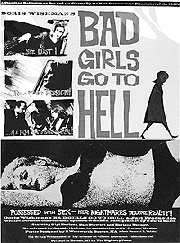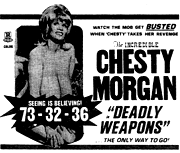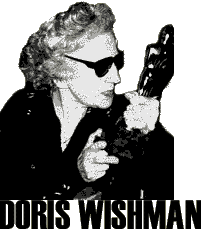 |
Doris Wishman
has been called the most prolific female filmmaker of all time. From the
'60s to '80s she produced a long series of underground, adult films, starting
out with the "nudies" of the early '60s ("Nudes on the Moon", "Blaze Starr
Goes Nudist") to the black and white, rough-sex morality plays of the
mid '60s ("Bad Girls Go To Hell", "A Taste of Flesh"), onward to the
fleshy adventure flicks with the melon-bosomed Chesty Morgan in the '70s
("Deadly Weapons", "Double Agent 73") and finishing up with the cursed
"A Night To Dismember" (1983) which starred ex-porn star and pop singer
Samantha Fox (!?!). (It should be noted that Doris is working on a comeback
film as we speak.)
The Nudies
Used to be, there were all sorts of newfangled laws that stopped people
from showing floppy, bouncing breasts or juicy, mouth-watering behinds
on the big screen. This sort of skin-censorship lasted up until the late
fifties when the arrival of the nudist movement demanded that people celebrating
the healthy lifestyle of nakedness be able to commit their activities
to celluloid. (It doesn't make much sense to me either.) As a result,
nudie films were born, in which viewers were treated to endless scenes
of nudists playing volleyball, nudists practicing archery, nudists performing
on the accordion and nudists doing pretty much everything except what
you want to see nudists doing - having sex. A young, recently widowed
Doris Wishman, fresh from working in the film distribution industry, threw
herself into making one of the early nudies, "Hideout in the Sun" (1960)
as a way of forgetting her husband's recent death from a heart attack.
The movie had enough success to allow Doris to film about eight more nudies
- the most amusing of these being "Nude on the Moon" (1961), a film that
documents the lifestyles of nudist aliens who speak telepathically - before
the genre starting collapsing in on itself when folks realized that watching
nude people playing with a beach ball was about as arousing as Barbra
Streisand in "Yentl." Sex needed an added sense of danger and
this led to.
The Roughies
Roughies were the next stage of adult cinema. While the nudies were achingly
innocent films, all about a "lifestyle", the roughies were what would
have happened had Rod Serling made films with naked people. While the
sexual content was fairly tame by today's standard, the grim stories of
good and bad women (or my favorite, good women gone bad) provided enough
danger to hook the last generation of sexually repressed Americans before
the late sixties sexual revolution hit. And Wishman was right at home
in this genre, where I feel she did her best work. Armed with black and
white film, and incorporating the hand held camera style seen in TV
shows like N.Y.P.D Blue, Wishman tackled an endless series of difficult
issues facing American society, like wives forced into prostitution ("Another
Day, Another Man" - 1966), women who kill their rapists ("Bad Girls Go
to Hell" - 1965) and magic voodoo dolls with strange sexual powers ("Indecent
Desires" - 1967). While there's an unavoidable degree of kitsch associated
with these films (a fact that disgusts Wishman herself) when one gets
past the low budget trappings, there really is something disturbing about
such films. In "Bad Girls." the camera is in a perpetual state of unease,
and uses the shadow and light so inherent in black and white films to
frame the good, the bad and the ugly in uncompromising terms. We also
see many instances of the famous Wishman cutaway shot, where, Wishman
(who had actors dub in most of the audio of her films) would focus on
an inanimate object while a subject was talking, in order to lessen the
work of synching voice to film in the editing room.
Another
movie that deserves special mention as one of Wishman's "roughies", despite
being filmed in color and having a release date of 1970, is "The Amazing
Transplant." Somewhat of a softcore film, it detailed the perils of a
young man whom, as young men are wont to do, has the penis of a dead man
transplanted onto his groin. Offering further argument that men think
with their dicks, the protagonist, a boyish lad named Arthur, transforms
from a mild mannered fellow to a serial rapist, whose sexual exploits
are detailed in the films many sex episodes. One such attack is perhaps
the most disconcerting rape scene ever committed to film - Arthur spends
several minutes simply trying to undress his victim, finally pinioning
her hand against the floor with his foot, and then fumbling around to
release his new phallus for the denouement. Unlike a lot of rape scenes
in more modern cinema, this one isn't over quickly, but rather plods along
with what I'd assume to be the pace of a real sexual attack.
The Chesties
Despite their name and reputation, the Roughies never really delivered
much graphic titillation, so when various Supreme Court rulings in the
late sixties freed up film makers to commit actual sex acts to film, that
genre, like Nudies before it died an untimely death. This put Doris in
a slightly uncomfortable position. In contrast to her underground reputation,
Doris was squeamish about filming real hardcore, and the lack of genuine
plots in such films left her empty. So in the mid seventies, she grabbed
attention by releasing two films laden with a pair of gimmicks that left
slack-jawed yokels peeling their chins off the sticky floors of adult
theatres. These gimmicks were a pair of FUCKING GIGANTIC breasts that
happened to be attached to a Polish stripper known as Chesty Morgan. Doris
and Chesty did two films together - "Deadly Weapons" (1973) and "Double
Agent 73" (1974) (named after Chesty's bustline) and they probably remain
as Doris's most popular works. In "Deadly Weapons" Chesty plays a successful
advertising executive whose Mafioso boyfriend is killed by his fellow hoods. Seeking
revenge, Chesty tracks down the killers (one of them played by "Deep Throat's"
Harry Reems) and literally suffocates them with her tits, which is probably
a better death than those guys deserved. Then, in "Double Agent 73" Chesty
is a spy who has a camera implanted in her breasts and proceeds to wipe
out a heroin ring, whom, for an undisclosed reason also appear to be communists.
However, despite the fact they were doing history making work together,
Doris found Chesty difficult to deal with and declined the final option
in their three-film contract. Chesty disappeared into obscurity (though
it's doubtful a woman like that could ever really be obscure) and Doris
went on to film.
A Night
To Dismember
While Doris' career had always been rife with struggle, it was the ill-fated
"A Night To Dismember" (1983) that seemed to diminish her desire to produce
films at her otherwise prolific rate. A movie she reportedly had a sizeable
financial and emotional investment in, ANTD was brought to an untimely
halt when a series of film negatives were destroyed in a laboratory accident
(or vandalism attack, depending on your source.) What was left was edited
together and released, but the disaster seemed to be enough to push Doris
away from film until recently, in which she started shopping around for
financing for her new film "Dildo Heaven" (sometimes referred to as "Desperate
Desires".)
Of course
the above is only a brief description of Wishman's work. To really appreciate
her genius, you need to call in sick to work, pour yourself the first of
many glasses of 211 malt liquor for the day, and treat yourself to a 24
hour retrospective of her films. When you do, I think you'll notice some
interesting themes running through most of her films. Like.
Feminist
or Feminaut?
While Doris has always actively denied allegations that she was a feminist,
or that there was a political motivation to her films, there is undeniably
something that separates Wishman adult films from the rest of the male
dominated industry. Her work in the roughies, a genre one would assume
to be about as misogynist as they come, is actually pretty sympathetic
towards women. (At least more so than non-Wishman adult films from the
same period like the plainly titled, "All Women Are Bad.") After viewing
"Bad Girls Go to Hell" which details the unfortunate story of Meg, who
after killing her rapist early on, spends the rest of the film being abused
by predators of both sexes in her quest to avoid imprisonment, one feels
a little cheated by the title. After all, the protagonist isn't really
bad - simply doomed because she's a woman. The same goes for the prostitute
wife in "Another Day, Another Man." Even Chesty Morgan's character in
"Deadly Weapons" is somewhat of a reluctant vigilante. she doesn't want
to turn her low hanging fruits into instruments of justice, indeed she's
plagued by doubt every step of the way, but she's given no choice when
the mob KILLS THE MAN SHE LOVES! (Tying in to the rage Doris may
have felt when her husband died? Who knows.) In the nudies, Wishman women
are na´ve tramps. In the roughies, they're bruised, sometimes hardened
victims. It's not until "Double Agent 73" that the more traditional, Gloria
Steinem style feminism makes its mark, and Wishman gives us the confident
cocky superbitch with the mind-blowing bosom. Damn, ain't that what the
women's movement was all about?
Camp
Wishman
It's impossible not to look over Wishman's films and smile. After all,
the crazy titles, the low budget filmmaking, the underground status -
it's all good for a laugh, right? But I've found that the more I get into
Wishman's films, the more I feel. guilty for simply regarding these films
as kitsch. Doris has made it expressively clear in various interviews
and commentary that she always saw herself as a serious filmmaker, no
different than the Scorseses and Spielbergs. And it was her singular eclectic
vision that kept her away from the studio dollars that would have allowed
her to put more sheen on her films. (Money that could've come from either
the mainstream or hardcore studios.) Certainly there are other bigger
film makers, who took the studio cash and make great, though presumably
compromised, films, but you can't help but look at little Doris Wishman,
who directed, wrote, cast and grabbed financial backing for all of her
films and not admire the FUCKING GALL it must have taken to do so. Suddenly
Doris looks less like a campy icon of the Ed Wood variety and more like
a singular force who's loyalty to her own muse left her stranded on the
sidelines.
However,
despite Doris's precarious position in the world of filmmaking, she seems
disinclined to give up. (One quote attributed to her is, "When I die,
I'll make films in hell.") She's seeking funding for her 27th film, "Dildo
Heaven" and is collaborating with author Michael Bowen on a book about
her life. Perhaps Doris will end up like Vincent Van Gogh, and her work
will not be totally appreciated until she's dead. Maybe in the year 2112,
people will sit back and watch Chesty Morgan suffocate someone with her
breasts or one of the moon nudies playing with a beach ball and say, "Ahhh.this
is art!"
We can only
hope.
UPDATE:
Doris passed away on the 10th of August, 2002. You can read the official
Acid Logic farewell to this American treasure, here.
Wil Forbis
is the pen named shared by such noted authors as James Ellroy, Katie Roiphe,
and Jim Thompson. E-mail him, I mean, them, at acidlogic@hotmail.com
View Wil's Acid Logic web log, a stirring endorsement
of sex with pandas!
|
Meet some other Interesting Motherfuckers:
Ray Walston by John Saleeby
From My Favorite Martian to Mr. Hand.
Mitch Hedberg by John Saleeby
The last of the comedy greats!
Al Jafee by Wil Forbis
Mad Magazine's cartoon master.
GG Allin by Wil Forbis
Even punks loathed the performer who pushed past the bouderies.
David Allan Coe by Wil Forbis
Country's obscene outlaw walks the line.
Bernie Casey by John Saleeby
The blaxploitation star who rose from the ghetto of professional football.
Bret Easton Ellis by Tom Waters
Peruse the critical overview and interview with the fiction superstar.
Phil Lynott by Wil Forbis
Thin Lizzy's frontman rose from the streets of Ireland to the heights of rock stardom and then descended into the pit of drug abuse.
Louis CK by Sean C Tarry
Marvel at this stand up's ability to phrase the opposite of every song.
Sho Kosugi by Wil Forbis
Fear the power of the Ninja! Fear it, Bitch!
Bill Hicks by Cody Wayne
The mind expanding comedian gets his due.
Warren Zevon by Xander Horlyk
A literary look at "a moralist in cynic's clothing."
Pam Grier by John Saleeby
Sweet Christmas! It's the queen of blaxploitation, Foxy Brown herself!
Jack Webb by John Saleeby
When he created the elite police unit of "Dragnet," Jack Webb laid the first blow against the scourge of America: Hippies!
Doris Wishman by Wil Forbis
The prolific adult film maker, whose work includes the classic Chesty Morgan movies, is probed and prodded.
Dave Thomas by John Saleeby
Wendy's Dave Thomas was all about Biggie Fries, Frosties and love.
Spike Milligan by John Saleeby
Read up on the life of the British comedy scribe.
Toshiro Mifune by Wil Forbis
The Japanese actor who slashed his way through a thousand samurai movies.
Nina Hagen by Wil Forbis
The Wagnerian Banshee who created the blueprint for punk/funk/opera.
Bob and Tommy Stinson by John Saleeby
Get to know the real talents of eighties punk sensations, The Replacements.
Tom Savini by John Saleeby
The king of latex gore.
And there's even more on our main page! |
|
|

Bad Girls
Go To Hell is Wishman's best known "roughie." It will cause
good girls to think twice about killing their rapists.

"Watch
the mob get BUSTED when Chesty takes her revenge."
|
 presents...
presents...
